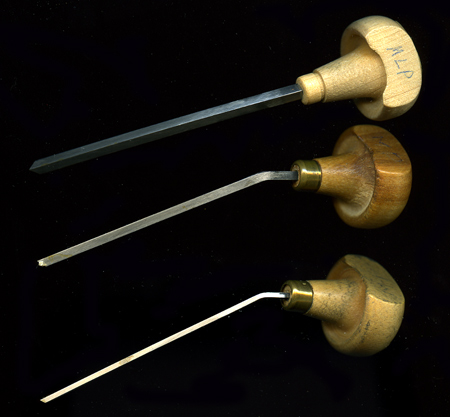100 yr old printshop

The printmaker in me was fascinated by an article in our paper about Canada’s first Chinese print shop still in operation here in Vancouver after a century, run by the third generation of the Lam family and the matriarch. The amazing printing presses, the antique stamps, the lead type are all rich in history, function and beauty, so do visit the video at the link. This is far different from current printing technology. All this heritage, including the building is fast disappearing as the family is selling off its contents and closing. Sad.
The image of engraving tools, burins, above is not related to the article, but as I did not have any images of those lovely stamps or types to place here, I thought of these. Not normally used in the type printing such as in this shop, they are the tools of an artist creating engravings on metal plates such as copper. I have had these since art school days, which was not quite as long ago as when this print shop opened up.
July 30, 2012 in Canada and BC, History, Printmaking, Tools and technology by Marja-Leena
That was an amazing video and story that also saddened me as I’m sure it did you. It’s such a shame every time one of these small and very unique companies can no longer compete with far less interesting modern production methods. I guess what worries me is the lack of general understanding about what exactly is being lost every time something that’s withstood the test of time is dumped for a high tech alternative.
Some of those stamps were real treasures, weren’t they? At the very least these things could be saved in a museum.
Susan, yes, it is such a loss of history and culture. I do hope our Vancouver Museum will look into this though I know they have run out of space and need a larger building. Did you notice at the end of the article some artists are snapping up some of the contents? It would be wonderful if these objects and even the presses could continue to be used rather than collecting dust somewhere.
That reminds me… back in 2002 when I was in Vaasa, Finland for an exhibition with two friends, we visited an outdoor museum called Stundars. There amidst many kinds of interesting old buildings, we found a small printshop with an elderly printer who demonstrated setting type and printing. We really enjoyed it even though he spoke mostly Swedish which none of us knew though I seem to recall my husband fared a little better with his German.
I did notice that artisans (mostly from the US) had been buying some of the contents. The Stundars Museum is an excellent project and one that could well be emulated in other countries.
The ‘evolutionary process’ from woodblock printing to the Gutenberg press, to lithography, to hot metal typing, to photo-typesetting, to the ink jet printer involves what techies would call ‘paradigm shifts but which a biologist might call extinctions. There is a lot of flexibility inherent in older technology but the idea of a perfect, upwardly arcing parabola of utopian progress disturbs me. My guess is that you probably agree.
Long ago, when I lived in a house with several (letterpress) presses, I was invited to go to a field near Pawtucket RI (can’t remember exactly where) that was a kind of junkyard for presses. Hundreds of presses stood at all angles in the field. I can’t remember what the people I was with were buying–type, I’m sure, but what else? But many people hunted for press bargains in that field… And no doubt many a small press has one of those machines, once covered in vines.
Susan, I do agree even while being guilty of using the latest technology – inkjet printers and computers. I’ve often hankered for my own etching press (not what is on offer in the Chinese print shop) but my studio is too small. Some day when we no longer have cheap or any electricity and oil, we may wish to have that old technology again, so let’s hope it sticks around!
Marly, that must have been a real sight! Rather sad really but glad there were some takers. Now if I were into making books…
Oh, this brings back tearful memories of my Grandpapa’s old business. He was a textile distributor specializing in satin, silk, and hand-made lace. What I would give for just one more day in his shop.
rouchswalwe, I can just imagine how lovely your Grandpapa’s shop must have been, and with such specail textiles like hand-made lace. I love fabric shops, in fact I had summer jobs in some as a student long ago. There aren’t as many of those around as there used to be….
What interesting books you could make… And broadsides.
Marly, yes indeed, if I had another lifetime to learn all the things I haven’t tried 🙂 “Broadsides?” – do you mean broadsheets? Words you don’t hear much these days.